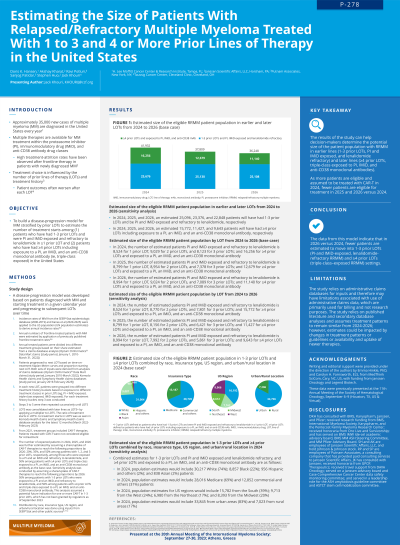Treatment of Relapsed/Refractory Myeloma
Poster Session 2
P-278: Estimating the Size of Patients With Relapsed/Refractory Multiple Myeloma Treated With 1-3 and 4 or More Prior Lines of Therapy in the United States
Thursday, September 28, 2023
12:30 PM - 1:30 PM EEST


Jack Khouri, MD
Physician
cleveland clinic
Cleveland, Ohio, United States
Introduction: Approximately 35,000 new cases of multiple myeloma (MM) are diagnosed in the United States every year. Multiple therapies are available for the treatment of MM across the proteasome inhibitor (PI), immunomodulatory drug (IMiD), and anti-CD38 antibody classes. However, evidence suggests that the number of patients eligible for treatment declines after exposure to these classes. The objective of this study was to build an MM disease progression model to estimate the size of the MM patient population with a historically high risk of progression stratified by (1) 1-3 prior lines of therapy (LOT) and (2) ≥4 prior LOT in the United States.
Methods: A disease model was developed starting with the annual incidence of MM and applying different treatment pathways to generate patient buckets based on treatments received in prior LOT. Patients were classified as having 1-3 prior LOT if they received 1-3 prior LOT and were PI- and IMiD-exposed and refractory to lenalidomide in at least 1 prior line. Patients were classified as having ≥4 prior LOT if they received ≥4 prior LOT including a PI, IMiD, and anti-CD38 monoclonal antibody (ie, triple-class exposed). Claims databases representative of the US MM population and public sources including the SEER*Stat epidemiologic database were used to obtain inputs for the model. Overall, the model estimated the number of patients in the US with 1-3 and ≥4 prior LOT by calendar year and stratified by race/ethnicity and payer-type subgroups.
Results: An estimated 25,096 patients would have had 1-3 prior LOT, and 15,772 would have had ≥4 prior LOT in 2024. In 2026, the population size is an estimated 22,848 patients with 1-3 prior LOT and 9,643 with ≥4 prior LOT. By race/ethnicity subgroups, the estimated population in 1-3 and ≥4 prior LOT combined would include 30,217 White (74%), 8,857 Black (22%), 956 Hispanic (2%), and 838 Asian (2%) patients in 2024 and 24,023 White (74%), 7,041 Black (22%), 760 Hispanic (2%), and 666 Asian (2%) patients in 2026. The estimated population in 1-3 and ≥4 prior LOT combined by payer type would be 28,016 Medicare (69%) and 12,852 commercial (31%) patients in 2024 and would include 22,702 Medicare (70%) and 9,789 commercial (30%) patients in 2026.
Conclusions: The data from this MM disease progression model indicate that fewer patients are anticipated to move into the 1-3 prior LOT, PI-exposed, and lenalidomide-refractory relapsed/refractory MM (RRMM) and ≥4 prior LOT triple-class exposed RRMM settings in 2026 versus 2024.
Methods: A disease model was developed starting with the annual incidence of MM and applying different treatment pathways to generate patient buckets based on treatments received in prior LOT. Patients were classified as having 1-3 prior LOT if they received 1-3 prior LOT and were PI- and IMiD-exposed and refractory to lenalidomide in at least 1 prior line. Patients were classified as having ≥4 prior LOT if they received ≥4 prior LOT including a PI, IMiD, and anti-CD38 monoclonal antibody (ie, triple-class exposed). Claims databases representative of the US MM population and public sources including the SEER*Stat epidemiologic database were used to obtain inputs for the model. Overall, the model estimated the number of patients in the US with 1-3 and ≥4 prior LOT by calendar year and stratified by race/ethnicity and payer-type subgroups.
Results: An estimated 25,096 patients would have had 1-3 prior LOT, and 15,772 would have had ≥4 prior LOT in 2024. In 2026, the population size is an estimated 22,848 patients with 1-3 prior LOT and 9,643 with ≥4 prior LOT. By race/ethnicity subgroups, the estimated population in 1-3 and ≥4 prior LOT combined would include 30,217 White (74%), 8,857 Black (22%), 956 Hispanic (2%), and 838 Asian (2%) patients in 2024 and 24,023 White (74%), 7,041 Black (22%), 760 Hispanic (2%), and 666 Asian (2%) patients in 2026. The estimated population in 1-3 and ≥4 prior LOT combined by payer type would be 28,016 Medicare (69%) and 12,852 commercial (31%) patients in 2024 and would include 22,702 Medicare (70%) and 9,789 commercial (30%) patients in 2026.
Conclusions: The data from this MM disease progression model indicate that fewer patients are anticipated to move into the 1-3 prior LOT, PI-exposed, and lenalidomide-refractory relapsed/refractory MM (RRMM) and ≥4 prior LOT triple-class exposed RRMM settings in 2026 versus 2024.
